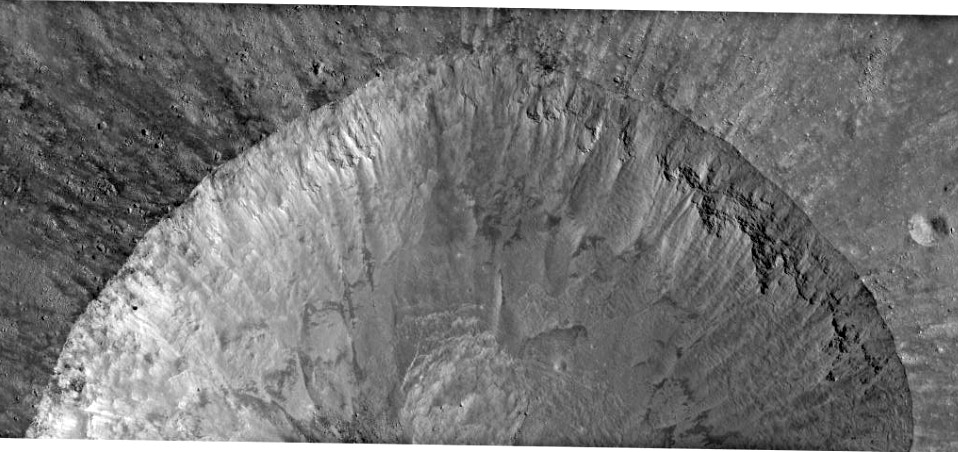Difference between revisions of "June 7, 2011"
| Line 3: | Line 3: | ||
<!-- ws:start:WikiTextHeadingRule:0:<h1> --> | <!-- ws:start:WikiTextHeadingRule:0:<h1> --> | ||
<!-- ws:start:WikiTextLocalImageRule:6:<img src="/file/view/LPOD-Jun7-11.jpg/234726954/LPOD-Jun7-11.jpg" alt="" title="" /> -->[[File:LPOD-Jun7-11.jpg|LPOD-Jun7-11.jpg]]<!-- ws:end:WikiTextLocalImageRule:6 --><br /> | <!-- ws:start:WikiTextLocalImageRule:6:<img src="/file/view/LPOD-Jun7-11.jpg/234726954/LPOD-Jun7-11.jpg" alt="" title="" /> -->[[File:LPOD-Jun7-11.jpg|LPOD-Jun7-11.jpg]]<!-- ws:end:WikiTextLocalImageRule:6 --><br /> | ||
| − | <em>LRO NAC image from [http://wms.lroc.asu.edu/lroc_browse/view/M154893929LR | + | <em>LRO NAC image from [http://wms.lroc.asu.edu/lroc_browse/view/M154893929LR NASA/GSFC/Arizona State University]</em><br /> |
<br /> | <br /> | ||
| − | Remember the [http://www.lpod.org/?m=20061008 | + | Remember the [http://www.lpod.org/?m=20061008 headlights] in the southeast quadrant of the Moon? Stevinus A and Furnerius A are small craters with bright and long rays. Both seem to have resulted from oblique impacts. The Lunar Reconnaissance Orbiter team has now released a wonderful image of part of Stevinus A. The excellent [http://lroc.sese.asu.edu/news/index.php?/archives/386-Dry-debris-or-liquid-flow.html#extended commentary]by Lillian Ostrach evaluates possible origins of the dark streamers on the inner wall just left of center. I want to enjoy the broader view of about half of the 8 km wide crater - essentially a scaled up version of [http://lpod.wikispaces.com/July+9%2C+2010 Linné]. The top 20% of the inner rim looks different on the left and right sides, presumably due to differences in illumination. On the right the short shadows reveal the edges of collapsed rocks. This looks too high up on the rim to be the level of pre-existing terrain so it must be the bouldery material ejected during formation. Stevinus A lies on the ejecta of the nearby relatively fresh Stevinus, so that the large boulders may have been originally excavated by that crater. Look at the full resolution [http://wms.lroc.asu.edu/lroc_browse/view/M154893929LR version] of this frame to see below the bouldery material unusual, thin veneers of landslide material that smoothes out underlying gullies and is crossed by bouncing boulder trains and more dark streamers. On the left this top area is bright, making the dark streamers more conspicuous. The top part of the streams is very roughly about the same level all around the crater wall, suggesting that it may be a layer originally at that level. On the upper left rocky dark streamers radiate away from the crater edge and a few are aligned with ones inside the crater. This is a fascinating feature and it will be intriguing to see if the dark streamers occur at about the same level on the other side of the crater.<br /> |
<br /> | <br /> | ||
| − | <em>[mailto:tychocrater@yahoo.com | + | <em>[mailto:tychocrater@yahoo.com Chuck Wood]</em><br /> |
<em>Warning: I will be at a meeting near Baltimore, Maryland until Friday evening and may not have a chance to do an LPOD every night.</em><br /> | <em>Warning: I will be at a meeting near Baltimore, Maryland until Friday evening and may not have a chance to do an LPOD every night.</em><br /> | ||
<br /> | <br /> | ||
Revision as of 16:35, 11 January 2015
Streaming Debris

LRO NAC image from NASA/GSFC/Arizona State University
Remember the headlights in the southeast quadrant of the Moon? Stevinus A and Furnerius A are small craters with bright and long rays. Both seem to have resulted from oblique impacts. The Lunar Reconnaissance Orbiter team has now released a wonderful image of part of Stevinus A. The excellent commentaryby Lillian Ostrach evaluates possible origins of the dark streamers on the inner wall just left of center. I want to enjoy the broader view of about half of the 8 km wide crater - essentially a scaled up version of Linné. The top 20% of the inner rim looks different on the left and right sides, presumably due to differences in illumination. On the right the short shadows reveal the edges of collapsed rocks. This looks too high up on the rim to be the level of pre-existing terrain so it must be the bouldery material ejected during formation. Stevinus A lies on the ejecta of the nearby relatively fresh Stevinus, so that the large boulders may have been originally excavated by that crater. Look at the full resolution version of this frame to see below the bouldery material unusual, thin veneers of landslide material that smoothes out underlying gullies and is crossed by bouncing boulder trains and more dark streamers. On the left this top area is bright, making the dark streamers more conspicuous. The top part of the streams is very roughly about the same level all around the crater wall, suggesting that it may be a layer originally at that level. On the upper left rocky dark streamers radiate away from the crater edge and a few are aligned with ones inside the crater. This is a fascinating feature and it will be intriguing to see if the dark streamers occur at about the same level on the other side of the crater.
Chuck Wood
Warning: I will be at a meeting near Baltimore, Maryland until Friday evening and may not have a chance to do an LPOD every night.
Related Links
Rükl plate 69



